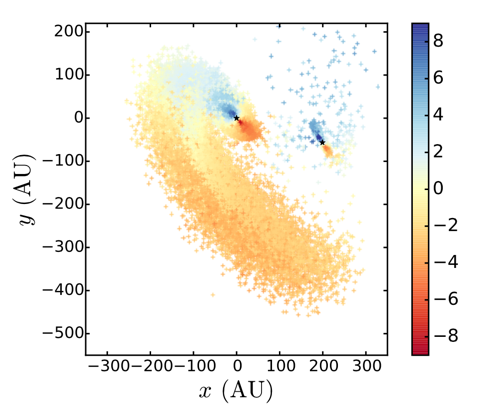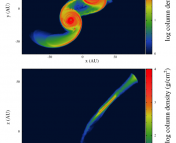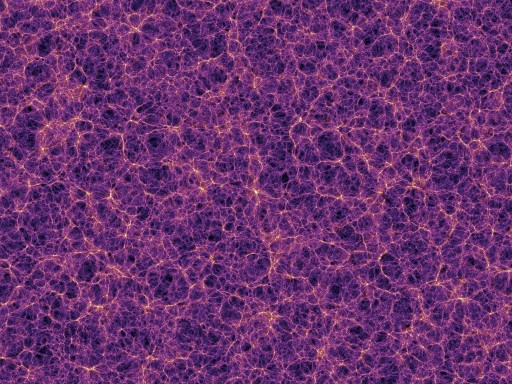- Title: A tidal encounter caught in the act: modelling a star-disc fly-by in the young RW Aurigae system
- Authors: Fei Dai, Stefano Facchini, Cathie J. Clark, and Thomas J. Haworth
- First Author’s Institution: Kavli Institute, MIT, Cambridge, USA and Institute for Astronomy, Cambridge, UK
- Paper Status: Accepted for publication in MNRAS

Illustration of the RW Aurigae system containing two stars (dubbed A and B) and a disk around Star A. The schematic labels the angles needed to define the system’s geometry and angular momenta. Fig. 1 from the paper.
Physical models in astronomy are generally as simple as possible. On the one hand, you don’t want to oversimplify reality. On the other hand, you don’t want to throw in more parameters than could ever be constrained from observations. But some cases deviate just enough from a basic textbook case to be really interesting, like the subject of today’s paper: a pair of stars called RW Aurigae that features a long arm of gas and dust wrapped around one star.
You can’t model RW Aurigae as a single star with a disk of material around it, because there is a second star. And you can’t model it as a regular old binary system either, because there are interactions between the stars and the asymmetric circumstellar disk. The authors of today’s paper create a comprehensive smooth particle hydrodynamic model that considers many different observations of RW Aurigae. They consider the system’s shape, size, motion, composition, and geometry, and they conduct simulated observations of the model for comparison with real observations.
A tidal encounter

Simulated particles in motion in RW Aurigae. This view of the smooth particle hydrodynamic model has each particle color-coded by its velocity toward or away from the observer (the color bar is in km/s). Star A is the one in front with a large tidally disrupted disk. Fig. 2 from the paper.
The best-fitting model of RW Aurigae matches observations of many different aspects as observed today, including particle motions. Because the model is like a movie you can play backward or forward in time, the authors are able to show that the current long arm of gas most likely came from a tidal disruption. This was long suspected to be the case, based on appearance alone, but this paper’s detailed model shows that the physics checks out with our intuition.
What exactly is a tidal disruption? Well, in this case, over the last 600 years or so (a remarkably short time in astronomy!), star B passed close enough to the disk around star A to tear it apart with gravity. Because some parts of the disk were significantly closer to star B than others, they felt different amounts of gravitational force. As time went on, this changed the orbits of individual particles in the disk and caused the overall shape to change. This is the same effect that creates tides on Earth: opposite sides of the Earth are closer or farther from the Moon’s gravity at different times, which causes Earth’s oceans on the far side from the Moon to feel less force than the water closer to it. The figure above shows present-day motions of simulated particles in RW Aurigae that resulted from the tidal encounter. The figure below shows snapshots from a movie of the hydrodynamic model, from about 600 years in the past to today. Instead of representing motion, the brighter regions represent more particles (higher density).

Snapshots of the RW Aurigae model over a 600-year time span as viewed from Earth. From top left to right bottom the times are -589, -398, -207, and 0 years from today, respectively. Brighter colors indicates higher density. There is a stream of material linking stars A and B in the bottom right panel, but it is not visible here due to the density contrast chosen. Fig. 4 from the paper.
Simulating observations
Observational astronomers are always constrained to viewing the cosmos from one angle. We don’t get to choose how systems like RW Aurigae are oriented on the sky. But models let us change our viewing angle and better understand the full 3D physical picture. The figure below shows the disk around star A if we could view it from above in the present. As before, brighter areas have more particles. Simulated observations, such as measuring the size of the disk in the figure below, agree well with actual observations of RW Aurigae.

Top-down view of the present-day disk in star A from the RW Aurigae model. The size of the model disk agrees with estimates from observations, and the disk has clearly become eccentric after its tidal encounter with star B. Fig. 9 from the paper.
The final mystery the authors of today’s paper explore is a dimming that happened during observations of RW Aurigae in 2010/2011. The model suggests this dimming was likely caused by the stream of material between stars A and B passing in front of star A from our line of sight. However, since the disk and related material are clumpy and still changing shape, they make no predictions about specific future dimming events. Interestingly, another recent astro-ph paper by Petrov et al. report another deep dimming in 2014. They suggest it may arise from dust grains close to star A being “stirred up” from strong stellar winds and moving into our line of sight.
Combining models and observations like today’s paper does is an incredibly useful technique to learn about how structures of all sizes form in the Universe. Tides affect everything from Earth, to stars, to galaxies. This is one of the first cases we’ve seen of a protoplanetary disk having a tidal encounter. The Universe is a messy place, and understanding dynamic interactions like RW Aurigae’s is an important step toward a clearer picture of how stars, planets, and galaxies form and evolve.





Cool article! I am wondering – if this tidal disruption is comparable to the moon’s tidal effects on the Earth, wouldn’t it average out over time? If these stars are a binary system, wouldn’t the tidal effects be felt periodically rather than in one “fly-by”? What was different about the single fly-by that was able to create the asymmetric cloud? Is the orbital period very long?
Hi Emily, good question. The magnitude of the tidal force isn’t necessarily the same as the Earth-Moon system, but it is the same physical effect. As I understand it, this system’s shape is changing fast enough that the orbit isn’t necessarily stable over time. So you can’t go backwards or forward with the hydrodynamic model enough to accurately predict what the final, stable state will be. If there are several orbits in the future, than yes, tidal forces will keep reshaping the disk after each flyby.
Very interesting effect! How common is it to have stars with so much matter surrounding them? I thought our models predicted that all this so close matter would eventually be absorbed by the star or used in the formation of planets.
It’s quite common, actually. You can read about T Tauri stars or protoplanetary disks to learn more. Systems like this are likely still in the process of forming planets, so it’s especially interesting to investigate how tidal disruptions affects that process.
What does the simulation suggest will happen to the gas and dust in the long run? Will it collapse into the star? Is something like this a long-term phenomenon, or something that will go away on a relatively short time scale?
Unfortunately the simulation can’t accurately project that far into the future. Great questions! In other single-star systems with disks of gas and dust like this, often planets will form.
Upon reading about tidal forces, I come across the concept of phase lag. It is the effect of rotation of the object undergoing a tidal force fighting against material responding to the tidal force to want to create a bulge. This is a bit easier to understand for a relatively stationary tidal force source and rotating planet (earth-sun) but interesting how these tides can deform such an asymmetric object with moving parts in the system!
This is a really cool example of how large-scale phenomenon like the merging of galaxies can be seen by analogy in stars and other smaller objects.
Really interesting post – it’s very cool how astronomers are able to get around physical constraints and “change” the viewing angle using their models, and even cooler when those simulations match reality!
Is it known what kinds of initial conditions lead to asymmetric disks or could generate this strange system with tidal effects? Basically I’m wondering what kinds of things could happen during formation that cause a deviation from the simple picture of collapse into star and disk where the disk is symmetric. (Is it collision or something else early in formation that could cause such a non-uniform distribution?
What I mean is if there is some external factor involved or is everything just internal
Excellent questions. The short answer is no, we don’t understand what causes systems like this to form in the first place. A pair of stars like this can form together, or they can encounter each other later by chance. We do have an idea of the range of masses that stars are born in, called the Initial Mass Function (low-mass stars are much more numerous than high-mass stars). However, the physics of WHY this happens is not well understood. It’s tricky when these things take too long to observe happening in real time!
Thanks for this post! I’m curious how the parameters in astronomical simulations are typically chosen when it is undesirable/impossible to model all parameters completely.
Hi Anne, this is a tricky business. Often you can constrain parameters based on what physically makes sense. For example, pretend you wanted to model something with a typical human in it, and you needed to assume a height. Obviously you wouldn’t choose 1 meter, or 10 meters. Probably something in between! It’s also possible to re-run a model with a different set of assumptions, and/or let your model iterate to find a best-fit solution. In this paper, the authors did a combination of both.
Has it been possible to simulate the system far in to the future? I imagine it would be revealing to observe the progression of the system to see the effects of this phenomenon a large time period after its occurrence.
While it’s possible to run the simulation far into the future, it won’t be very accurate. The simulation only models how particles move, so we can’t use it to say for sure if planets will form or what the ultimate fate of the gas and dust in the disk will be. Any small inaccuracies will only get larger with time, and while the model is good, it’s not perfect.
Is there an effect on either of the stars luminosity from the tidal disruption? Could that also contribute to a steady lessening or brightening of the system in addition to the periodic dimming?
Interesting idea, McKenna. It’s true that some binaries can be tidally distorted by a companion and cause very measurable changes in brightness as they orbit each other. (Cataclysmic Variables, X-ray binaries, and heartbeat stars often show this kind of thing.) However, the size of this system is too large – the stars are some 200 AUs apart. Because of this, the stars are essentially treated as points with no discernible size or shape in the model. They never get close enough together for tidal forces to affect the stars themselves. Good thinking, though!
Current idea seems to indicate that single stars will form from a symmetrical parent gas cloud. Since most parent gas clouds are not symmetrical, single stars are in the minority, about 40%-ish.